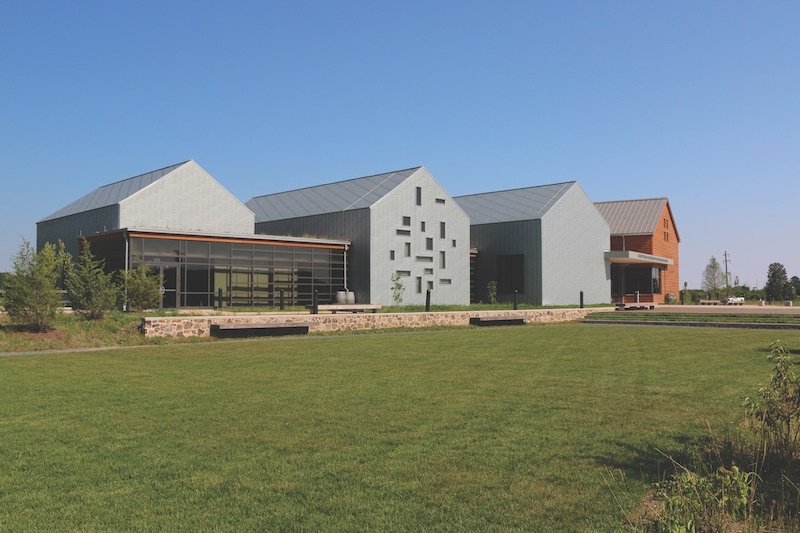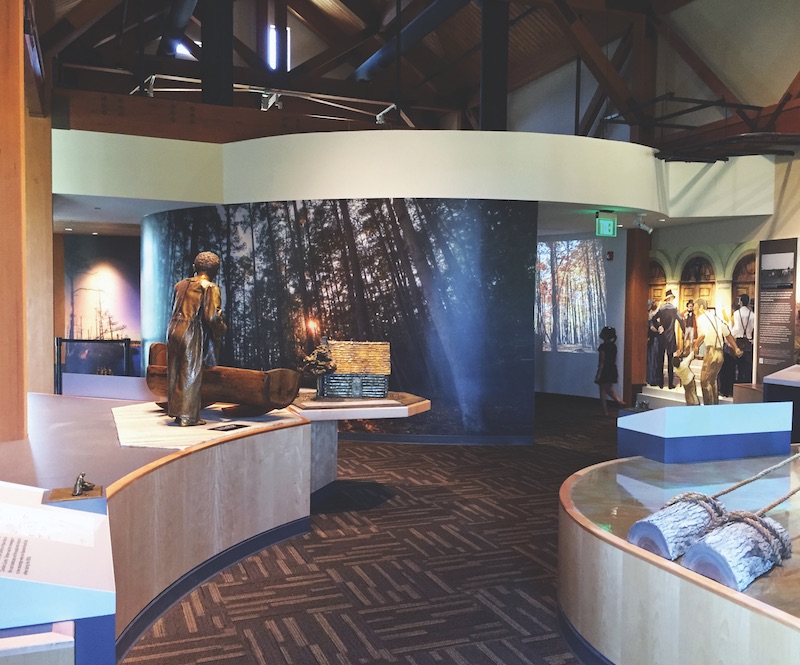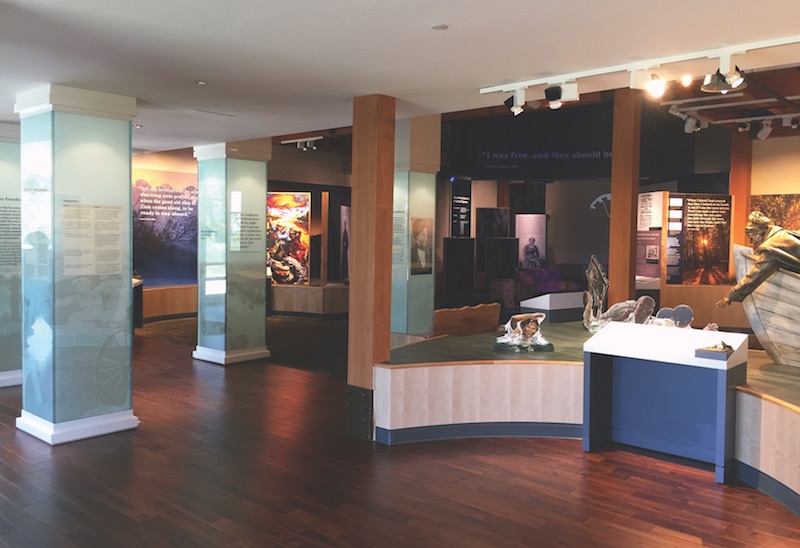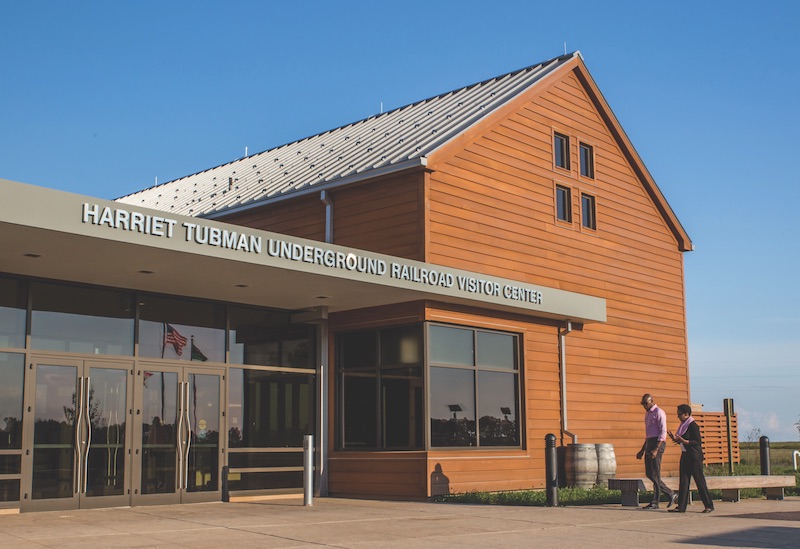The $21 million, 15,000-sf Harriet Tubman Underground Railroad Visitor Center in Church Creek, Md., uses engaging displays and exhibits to tell the story of Harriet Tubman’s life. The building’s design expresses the importance of traveling northward to escape the circumstances of slavery through an integrated site, building, and exhibit design.
The museum is conceived as a series of abstracted forms made up of two main structures, one administrative and one exhibit. The structures are joined by a shared entry plaza and terrace.
 Photo: Dorchester County Tourism.
Photo: Dorchester County Tourism.
The space between the buildings grows wider as visitors move north—a metaphor for freedom—while the view to the south is truncated by the splay of the building—meant to suggest a sense of oppression.
The design firm, GWWO Inc./Architects, used three volumes to memorialize the fates of the enslaved in the region: be sold, stay in fear of being sold, or run away. As visitors make their way north, they can take detours to other parts of the museum to discover and learn. After passing through the museum, visitors are directed toward a memorial garden that heads north before weaving through the site and returning to the beginning. This garden’s path is meant to represent Tubman’s circuitous routes and willingness to return to the region.
 Photo: Dorchester County Tourism.
Photo: Dorchester County Tourism.
A series of exhibit galleries, an orientation theater, a museum store, an information desk, a research library, offices, and support spaces are all included in the museum, which opened to the public in March.
 Photo: Dorchester County Tourism.
Photo: Dorchester County Tourism.
Related Stories
| Aug 11, 2010
Jacobs, HDR top BD+C's ranking of the nation's 100 largest institutional building design firms
A ranking of the Top 100 Institutional Design Firms based on Building Design+Construction's 2009 Giants 300 survey. For more Giants 300 rankings, visit http://www.BDCnetwork.com/Giants
Museums | Aug 11, 2010
Design guidelines for museums, archives, and art storage facilities
This column diagnoses the three most common moisture challenges with museums, archives, and art storage facilities and provides design guidance on how to avoid them.
| Aug 11, 2010
Museum celebrates African-American heritage
The Harvey B. Gantt Center for African-American Arts + Culture recently completed construction on the Wells Fargo Cultural Campus in Charlotte, N.C. Designed by the Freelon Group, Durham, N.C., with Batson-Cook's Atlanta office as project manager, the $18.8 million project achieved nearly 100% minority participation.
| Aug 11, 2010
Design for Miami Art Museum triples gallery space
Herzog & de Meuron has completed design development for the Miami Art Museum’s new complex, which will anchor the city’s 29-acre Museum Park, overlooking Biscayne Bay. At 120,000 sf with 32,000 sf of gallery space, the three-story museum will be three times larger than the current facility.
| Aug 11, 2010
Thom Mayne unveils ‘floating cube’ design for the Perot Museum of Nature and Science
Calling it a “living educational tool featuring architecture inspired by nature and science,” Pritzker Prize Laureate Thom Mayne unveiled the schematic designs and building model for the Perot Museum of Nature & Science at Victory Park in Dallas. The $185 million, 180,000-sf structure is 170 feet tall—equivalent to approximately 14 stories—and is conceived as a large...
| Aug 11, 2010
Piano's 'Flying Carpet'
Italian architect Renzo Piano refers to his $294 million, 264,000-sf Modern Wing of the Art Institute of Chicago as a “temple of light.” That's all well and good, but how did Piano and the engineers from London-based Arup create an almost entirely naturally lit interior while still protecting the priceless works of art in the Institute's third-floor galleries from dangerous ultravio...
| Aug 11, 2010
The Art of Reconstruction
The Old Patent Office Building in Washington, D.C., completed in 1867, houses two Smithsonian Institution museums—the National Portrait Gallery and the American Art Museum. Collections include portraits of all U.S. presidents, along with paintings, sculptures, prints, and drawings of numerous historic figures from American history, and the works of more than 7,000 American artists.
| Aug 11, 2010
Silver Award: Please Touch Museum at Memorial Hall Philadelphia, Pa.
Built in 1875 to serve as the art gallery for the Centennial International Exhibition in Fairmount Park, Memorial Hall stands as one of the great civic structures in Philadelphia. The neoclassical building, designed by Fairmount Park Commission engineer Hermann J. Schwarzmann, was one of the first buildings in America to be designed according to the principles of the Beaux Arts movement.








